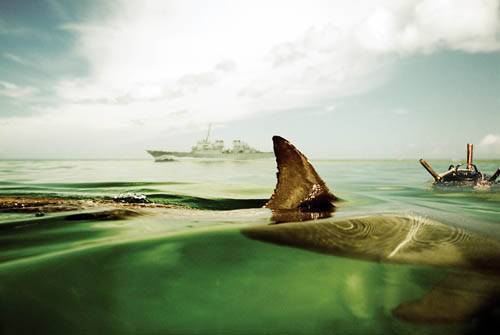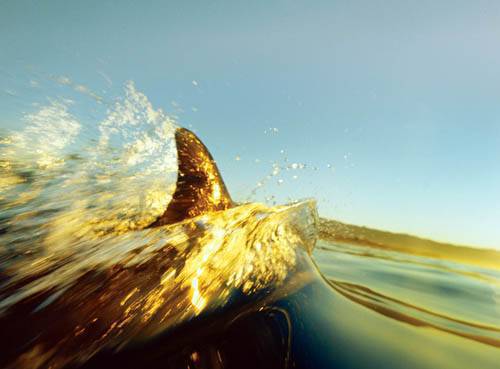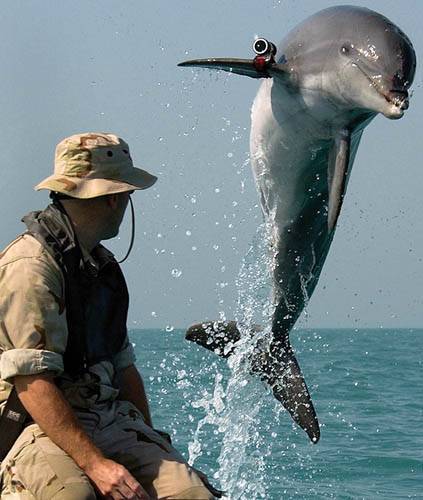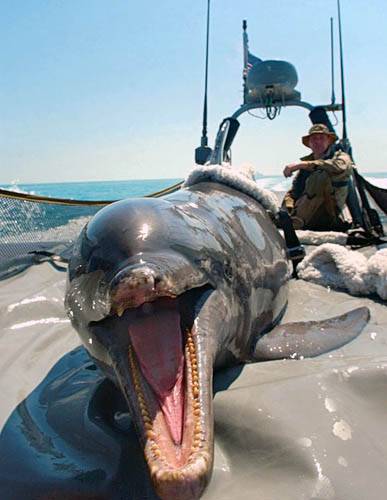Fighting dolphins

It is believed that a person possesses the largest brain on Earth in relation to body weight. With a mass of 100 kg, his brain weighs 1,5 kg. A similar ratio in dolphins. The brain of a white-sided dolphin weighing about 50 – 100 kg weighs about 1 kg. And bottlenose dolphins - almost 2 kg! (Brain 100-kg shark weighs only a few dozen grams)
It's no secret that war is the engine of progress. To achieve military superiority, people are ready to use any means, even to attract animals to their side. As a result, absolutely unique divisions of saboteurs appeared.
The idea of turning marine mammals into soldiers did not originate anywhere, but in Russia. Back in 1915, the trainer Vladimir Durov turned to the Navy General Headquarters, who suggested neutralizing underwater mines with the help of seals. The Ministry of Defense became interested, and for three months 20 animals were trained in Balaklava Bay. During demonstration training, they easily found underwater models of anti-ship mines and tagged them with special buoys. But it was not possible to apply seals in combat conditions. The Germans were worried about the appearance of an unusual special forces unit, and one night all the “sea sappers” were poisoned. Military counterintelligence began investigating this dark crime. Unfortunately, it was not possible to complete it. Revolution broke out, and the case of the death of combat seals was closed. When the Bolsheviks came to power, there was a danger that the enemy’s secret methodological literature on the training of pinniped saboteurs would be in the hands of the enemy, so most of the documents were destroyed.
Fighters saboteurs
Repeated to taming marine mammals and using them for military purposes, people returned half a century later, during the Vietnam War.
This time, the Americans achieved tremendous success. Along with seals and sea lions, they began to attract dolphins to underwater work. Their first baptism of fire was the patrol of the largest US naval base in Vietnam - Kamrani. By 1970, the operation "Quick Search" involved six animals trained on the basis of San Diego. The inhabitants of the sea helped to catch more than 50 swimmers-saboteurs who tried to attach magnetic mines to the sides of American ships. Moreover, as the military claimed, there were cases when sea lions destroyed the swimmers themselves using knives or needles with poison fixed to the nose. According to the stories of former special forces of the Black Sea fleet, while two Soviet scuba divers were killed.
Obviously, this inspired Soviet specialists to resume work with marine animals. In 1967, the first Soviet military aquarium was opened in the Cossack Bay of Sevastopol. 50 bottlenose dolphins were supplied for allowances. In 1970-x several dozen scientific institutions of the USSR joined the work. “Dolphins and seals were trained in several areas: protection and patrolling of the area, destruction of saboteurs, search and detection of various underwater objects,” says Vladimir Petrushin, the chief military trainer of the Sevastopol Oceanarium.
The training took place on the basis of long-established patterns: action - reinforcement. Animals developed the skills of the desired behavior. For the assignment they received a fish. However, having understood the meaning of what is happening, the dolphins took the initiative and themselves proposed some kind of cooperation algorithms. Soon managed to achieve good results.
“I attended military exercises when dolphins searched for saboteurs in the Sevastopol Bay,” says Lev Mukhametov, head of the group of marine mammals at the Research Institute for Ecology and Evolution of the Russian Academy of Sciences. - The spectacle is unforgettable. The entrance to the port there is very narrow, only 700 m. On the shore there were permanent checkered enclosures in which animals were kept. Bottlenose dolphins using their natural sonar, even sitting shut up, are able to notice any underwater object at a distance of about half a kilometer. So, finding swimmers, they pressed a special pedal. A rocket went up in the air and an alarm went off. Then the beast got up so that indicated the approximate location of the "guest". Then he pressed on the other pedal, and the door of the aviary opened. Dolphin rushed to the offender and neutralized him. " In September, 1973, the Oceanarium, was visited by the Commander-in-Chief of the Navy, Admiral Gorshkov, who was pleasantly impressed by what he saw. Marine mammals found saboteurs in 80% of cases. The situation with night swimmers was somewhat worse - 28 – 60%. True, without leaving the coastal aviary. On the high seas, the detection probability was close to 100%.
“It’s simply impossible to hide from a dolphin,” says coach Vladimir Petrushin. - Yes, and to fight with him under water to a person not with his hand. We held regular exercises. The GRU swimmers were given the task of entering the protected area, and at this time we were releasing animals. As a result, there was not a single breakthrough. Sometimes swimmers preferred to immediately get out on old abandoned buoys or breakwaters and basked in the sun, while dolphins were in control in the “combat” zone. Because of this, a lot of misunderstandings arose, because we thought that there were people in the area and demanded that animals look for them. And they showed that nobody is there. And just before the demobilization, the police had admitted that all this time they had simply fooled the command and had not thought of carrying out their task. ”
“Contrary to the general opinion, Sevastopol dolphins were not trained to kill people,” continues Lev Mukhametov. - Otherwise, they would just start attacking their own, because it is difficult for an animal to distinguish our diver from someone else's animal. Therefore, having reached the goal, they only tore flippers, a mask from the saboteur, and pushed it to the surface. But this was quite enough. Meanwhile, a speedboat with special forces was leaving the shore, and it was picking up the hapless scuba diver. ”
Nevertheless, combat weapons (knives, needles with paralyzing or poisonous substances, and even pistols worn on the nose and triggered by an impact) were in the arsenal of special forces. But, as practice has shown, after the lethal attack, the dolphins experienced severe stress and often sabotaged further orders; it was not for nothing that legends were made about their benevolence towards people. Therefore, the Soviet and American experts tried not to bring matters to the extreme. Another thing - sea lions and seals. Without any remorse, they poked people with poisoned needles.
From 1975, the marine mammals combat detachment took up state duty in the Sevastopol bay and, together with the special forces detachment, carried round-the-clock patrols. Each shift was a four-hour watch, leaving the position on a special channel at the Konstantinovsky Ravelin. But the service of combat dolphins was not limited only to identifying enemy spies.

The dolphin's brain has a complex structure and a very large number of convolutions of the cerebral cortex, the highest part of the brain responsible for complex mental functions. A highly developed brain is a high intellect, highly organized, complex behavior. Dolphins are skilled hunters, caring parents, disciplined members of the pack, and, if necessary, skilled leaders.
Underwater search
In March 1973, the naval leadership received the secret report of the US Navy Center in San Diego, which stated that in two years the Americans had managed to train a group of dolphins and two more killer whales to find and raise sunken combat torpedoes. Similar experiments immediately began to be carried out in Sevastopol. In February, 1977, another subdivision appeared on the Black Sea Fleet - the search unit. That it glorified the aquarium and brought great benefit to the fleet.
“The ability of dolphins to successfully search for lost items hit our coaches,” says Vladimir Petrushin. “They could even find the bolts and nuts that were once shown to them and then scattered across the bay’s waters.” It was a sin not to use such outstanding talents in practice, the good and the reason for this was.
On specially designated landfills in the Black Sea, ship shooting took place constantly. And although the command was taking all precautions, the sailors lost several training torpedoes per year. Finding their divers was almost impossible. Having lost the course, the torpedo sank and immediately burrowed into deep mud. This is where the help of the dolphins was needed.
“The bottlenose dolphins have excellent acoustic radar,” says Lev Mukhametov. “At the same time, it is much more perfect than all technical devices of a similar nature, which man invented and did. With the help of the sonar, animals can not only find even the smallest fish in the water, but also look under the ground to half a meter depth. And at the same time, they accurately determine what the sunken object is made of: wood, concrete or metal. ”
In practice, it looked like this. Dolphins on the muzzle wore special backpacks with audio beacons and buoys with anchors. Having found the lost torpedo, they swam up to it, poked their noses into the ground and dropped the audio beacon along with the buoy. And then divers entered into the business.
According to the military, the creation and maintenance of the service of combat dolphins in Sevastopol paid off in a few years. One training torpedo cost about 200 000 Soviet rubles, and these torpedoes saved hundreds of animals! At the same time, they discovered such things that the admirals themselves had long forgotten about. “I myself witnessed how, during the exercises, our dolphin came across an automatic mini-submarine that had been lost 10 years ago,” says Lev Mukhametov. - He put the buoy, and when the object was lifted onto the ship, there was no limit to the joys of the military, because the submarine had long been desperate to find, written off and got a good scolding from the authorities. And here for everyone turned up a good opportunity to improve. "
In their specialty, search dolphins have achieved incredible skill. They even mastered underwater photography. Especially for special units was developed a camera that can withstand the depths above 100 meters. The animals were taught to direct the lens at the target, freeze, and only at that moment release the shutter. One of the difficulties with underwater photography was that a powerful flash blinded animals, so I had to teach them to close their eyes. Then, using photographs, it was easy to determine what lies behind the find and whether it is worth wasting power on its rise.
Sometimes civilian agencies asked for help from the military. For example, at the request of archaeologists fighting dolphins searched and found the remains of ancient ships. With their help, ancient Greek amphoras and other antiquities rose from the bottom.

A dolphin-photographer uses a camera that can withstand depths above 100. The animal can correctly direct the lens to the target, freeze and only at this moment release the shutter.
Failed biorobots
Naturally, all these tricks required remarkable mental abilities. “Dolphins are very intelligent and funny creatures, and all the work was given to them easily,” says Alexander Supin, head of the laboratory at the Research Institute for Ecology and Evolution of the Russian Academy of Sciences. “Some scientists are seriously talking about the presence of the beginnings of intelligent activity in them — meanwhile, this very mind sometimes interfered with the military.”
For a long time, Navy analysts had toyed with the idea of turning dolphins into suicide bombers, but to no avail. By some sixth sense, the animals understood that they wanted to be sent to certain death, and refused to obey the commands. It was then that the military thought about whether to turn the dolphins into living robots.
“Existing technologies and technical means made it possible to achieve this,” Alexander Supin continues. - Passing an electric current through certain areas of the brain, you can create the illusion of loud sounds or light flashes. If the flash is on the one hand, the animal is frightened and swims to the other. This also ensures that his movements are controlled to the right or left. You can also make him stop or swim faster. For example, in the direction of the ship with a mine on the back. But these experiences were quickly abandoned. ” Too complicated were brain surgery. And the scientists themselves for the most part did not want to disfigure the animals and burn their brains with electricity. Yes, and "biorobot" were extremely painful creatures. Very soon the military closed the project, although experiments on implanting electrodes in dolphins' heads for purely scientific purposes were carried out for a long time. For example, with their help, the Scientific Research Institute for Ecology and Evolution of the Russian Academy of Sciences succeeded in making an outstanding discovery: one-hemispheric sleep was registered with dolphins. Soon, however, all invasive (with internal penetration into the body) experiments on dolphins in most countries were prohibited.
Currently, no self-respecting scientific journal will publish the results of experiments that used methods that cripple these animals.

Persian Gulf Storm
In 1991, after the collapse of the Soviet Union, the dolphinarium in Sevastopol came under the jurisdiction of Ukraine. Almost immediately, all military experiments with animals were stopped. Strong coaches quit and now work mainly in the Moscow Dolphinarium. The restless oceanarium survived by preparing performances for the public, but the situation continued to deteriorate. In 2000, the media leaked information that three dolphins and one beluga white of the Soviet conscription were sold to Iran. Ukrainian officials were quick to say that "purely for peaceful purposes."
Meanwhile, in the US, military research continues. To date, the seven special bases of the US Navy are working on various programs 250 animals. Due to the increasing pressure of the “greens”, as well as for security reasons, all these experiments are classified, so little is known about them. According to US media reports, one of the units is already guarding the waters of the Kings Bay naval base in the state of Georgia, and in the near future it is planned to use them to protect the Bangor base in the state of Washington, where Ohio-class submarine nuclear submarines are stationed.
The training of members of this special squad was tested in a combat situation during Operation Desert Storm. Off the coast of Kuwait, marine animals first cleared the area from enemy swimmers, and then began to detect mines. During the second Iraq war, dolphins were actively used for demining the Iraqi port of Umm Qasr. In 2003, nine animals were brought to the Gulf region. With their help, more than 100 mines were detected in the harbor. Joint service of a man and a dolphin, especially in combat conditions, brings them closer together. People seek to honor their comrades. For outstanding service, one of the dolphins named Tuffy was recently solemnly promoted to sergeant of the US Navy.
Now India, Iran, Israel and a number of other states are showing interest in fighting dolphins. Meanwhile, in the unanimous opinion of the staff of the Institute of Ecology and Evolution, it is much more productive to use dolphins not for military purposes, but for peaceful purposes. For example, they can be very effective in inspecting underwater structures, in particular gas pipelines. The dolphin is able to notice any mechanical damage or a trickle of gas coming out of the pipe, take a picture of them, fix the cables by which you can flush the necessary equipment under water. The institute's specialists are ready to offer their services in preparing the first civilian dolphin division in the world, whose tasks will include maintenance and monitoring of the state of the European gas pipeline laid under the Baltic Sea. And who knows, maybe the use of dolphins for peaceful purposes will greatly benefit science and open up two new ways for full cooperation to the two most intelligent biological species on Earth. And this, you see, is much more interesting than war.
Information